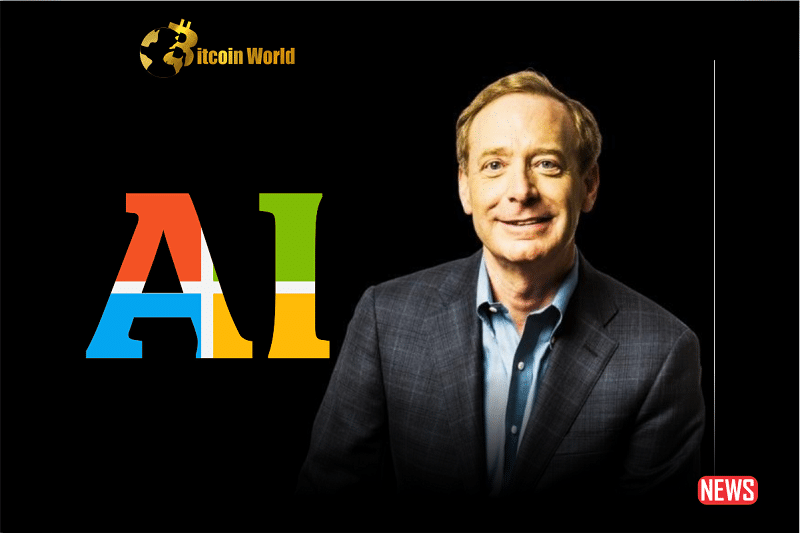Imagine a world where technology evolves faster than our ability to understand and control it. That’s the landscape we’re navigating with Artificial Intelligence (AI). Recently, Brad Smith, the President of tech giant Microsoft, stepped into the spotlight, delivering a powerful message: it’s time for governments and corporations to kick AI regulation into high gear. Why the urgency? Let’s dive in.
Why the Rush for AI Regulation?
Speaking in Washington, D.C., Smith didn’t mince words. He highlighted the growing anxieties surrounding AI – and for good reason. We’re talking about:
- Privacy Concerns: How is our data being used and protected in increasingly sophisticated AI systems?
- Job Displacement: As AI becomes more capable, what impact will it have on the workforce?
- The Deepfake Dilemma: The rise of hyper-realistic fake videos spreading misinformation is a serious threat to trust and truth.
Microsoft, a key player in the AI arena, isn’t just standing on the sidelines. Smith emphasized a shared responsibility, assuring that the company is committed to navigating this technological frontier safely and ethically.
What Concrete Steps Are Being Proposed?
So, what does this accelerated regulation actually look like? Smith proposed some tangible measures, moving beyond just talk to potential action:
“Safety Brakes” for Critical Infrastructure: A Necessary Precaution?
Think about AI controlling power grids, transportation systems, or even healthcare equipment. Smith advocated for built-in “safety brakes” in these high-stakes AI systems. This would allow for human intervention or system shutdown in case of unexpected behavior or potential danger. It’s like having an emergency stop button for AI.
Building the Legal Framework: What Rules Do We Need?
Imagine driving without traffic laws – chaos, right? Smith argues that AI needs its own set of rules – a comprehensive legal and regulatory framework. This framework would define responsibilities, set boundaries, and provide a structure for accountability.
Should Companies Take the Lead?
While government intervention is crucial, Smith stressed that companies can’t just wait for regulations to appear. He believes businesses developing AI have a responsibility to proactively mitigate risks. It’s about taking ownership and building safety into the development process from the ground up.
Licensing and Oversight: A Glimpse into the Future of AI Governance?
The idea of licensing AI developers, championed by OpenAI’s CEO Sam Altman, also received support from Smith. He suggested focusing this licensing on high-risk AI services and development, potentially within designated and monitored AI data centers. Think of it like this:
| Aspect | Description |
|---|---|
| Licensing | Ensures developers meet certain standards and are accountable for their AI creations. |
| Oversight | Allows for monitoring of high-risk AI activities, ensuring compliance and safety. |
| Accountability | Provides a clear line of responsibility for the development and deployment of AI technologies. |
This approach aims to strike a balance between fostering innovation and managing potential risks.
The Growing Chorus for AI Oversight: Is the Tide Turning?
Smith’s call isn’t happening in a vacuum. Concerns about AI are reaching a fever pitch. Consider these recent events:
- Sam Altman’s Testimony: OpenAI’s CEO himself advocated for a federal oversight agency to issue licenses to AI companies before Congress.
- The Open Letter: Influential tech figures, including Elon Musk and Steve Wozniak, signed a letter urging a temporary pause on AI development to allow society to catch up.
These developments signal a growing consensus: the time for serious AI oversight is now.
Microsoft’s Role: Walking the Talk?
As a major player in AI development, particularly with its investment in OpenAI and ChatGPT, Microsoft faces scrutiny. Smith addressed this head-on, reiterating the company’s commitment to internal AI safeguards, regardless of government mandates. Their investment in specialized chips to power advanced AI models like ChatGPT demonstrates their deep involvement in this space.
The Path Forward: Collaboration is Key
Brad Smith’s message is clear: navigating the complexities of AI requires a collaborative effort. Governments and corporations must work hand-in-hand to proactively address the potential downsides of this powerful technology. From establishing clear regulatory frameworks to implementing robust safety measures, the goal is to ensure AI benefits humanity without unleashing unforeseen risks. The conversation has begun, and the urgency is palpable. The future of AI depends on the actions we take today.
Disclaimer: The information provided is not trading advice, Bitcoinworld.co.in holds no liability for any investments made based on the information provided on this page. We strongly recommend independent research and/or consultation with a qualified professional before making any investment decisions.


